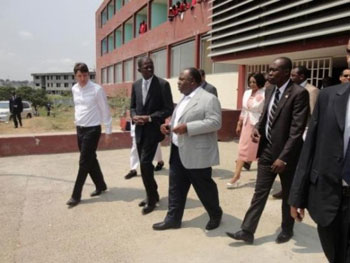 The Gabonese President, accompanied by Lucas Abaga Nchama, Governor of the Bank of Central African States (BEAC), inaugurated the new head office of the Central African Banking
The Gabonese President, accompanied by Lucas Abaga Nchama, Governor of the Bank of Central African States (BEAC), inaugurated the new head office of the Central African Banking
Commission (COBAC) entrusted with the control and independent supervision of the banking and financial system of the six CEMAC countries: Cameroon, Central African Republic, Congo, Gabon, Equatorial Guinea and Chad.
AMERICAN CHAMBER OF COMMERCE IN CAMEROON
ECONOMIC NEWS
CEMAC Banks: A cash surplus of 4.5 billion Euros
Cameroonian Employers contest the « good score » given by Doing Business
During the last meeting of the Board of Directors of the 295-member Employers' Movement, Protais Ayangma Amang, President of Cameroon Enterprises (ECam), his Vice Presidents Célestin Tawamba, Jean Perrial Nyodog and the Director General Christian Pouth, discussed several issues concerning the development of SMEs and the 2012 Doing Business classification.
Eto’o intends to invest in Cameroonian telecoms
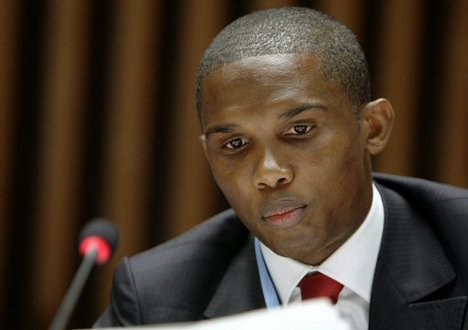 According to the communication services of the Cameroonian Post and Telecommunications Ministry, soccer star Samuel Eto'o is said to have opened up to the Minister about his desire to invest in his country's telecoms sector.
According to the communication services of the Cameroonian Post and Telecommunications Ministry, soccer star Samuel Eto'o is said to have opened up to the Minister about his desire to invest in his country's telecoms sector.
«During the audience, the soccer star said that he had come to inform the Minister about his intention to invest in the telecommunications sector, as virtual telephony operator. The Posts and Telecommunications Minister hailed this initiative which, in his view, will help reduce the digital divide in our country, on the one hand, and slash communications costs, on the other » the release stated.
According to the site www.camereco.com, « the procedures have quite advanced» and would serve to rekindle discussions about creating a mobile virtual telephony company or MVNO (Mobile Virtual Network Operator).
It remains unclear whether Camtel, the operator with exclusive management rights over the Cameroonian fibre optic, has the capacity to provide all the required services to a MVNO.
The new COSUMAF Regulation is favorable to foreign investors
The financial market of the Economic and Monetary Community of Central Africa has to provide its supervisory committee, the COSUMAF, a General Regulation. To analyze the significance of this reform, we turned to Boris Mortor, partner at Eversheds Law Firm.
Les Afriques : under what conditions these new rules were created ?
Boris Mortor : The General Rules of COSUMAF, the oversight Commission of the financial market, supervisory authority and control of the regional organization of central Africa, is the fruit of several years of dialogue and consultation among the six member states of CEMAC. After a first draft presented in 2005 at the COSUMAF College, the governing body of the supervisory committee, the General Regulation was finally adopted by the latter in July 2008, to enter definitively into force this year 2009.
Cameroon and Côte d'Ivoire seek to keep their public wage bill under control
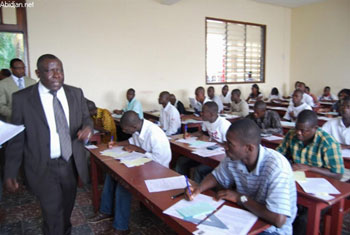 The Cameroonian and Ivorian governments are engaged in public expenditure reduction operations through vast censuses targeting public servants. In Cameroon, the campaign which will extend from 10 August to 10 October2011, requires public servants, contract officers and subordinate staff to register on line from their workstations.
The Cameroonian and Ivorian governments are engaged in public expenditure reduction operations through vast censuses targeting public servants. In Cameroon, the campaign which will extend from 10 August to 10 October2011, requires public servants, contract officers and subordinate staff to register on line from their workstations.
CAMAIR-CO conquering the African sky
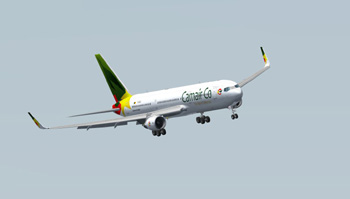 The new Cameroonian airline intends to cover about a dozen destinations in Africa this month; a deployment meant to strengthen the competitiveness of CAMAIR-CO, whose activities were launched in very difficult circumstances.
The new Cameroonian airline intends to cover about a dozen destinations in Africa this month; a deployment meant to strengthen the competitiveness of CAMAIR-CO, whose activities were launched in very difficult circumstances.
The era of major projects
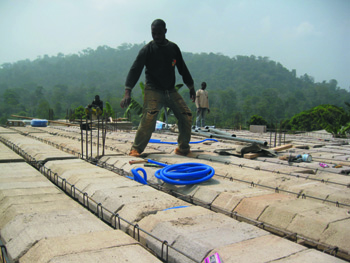 A few months before the end of his seven-year term, Paul Biya can boast of having placed most his major projects in the pipeline. Ready for implementation, many are at their start-up phase and many more, among the most emblematic in the energy, water and port infrastructure sectors, will be completed before the end of his term.
A few months before the end of his seven-year term, Paul Biya can boast of having placed most his major projects in the pipeline. Ready for implementation, many are at their start-up phase and many more, among the most emblematic in the energy, water and port infrastructure sectors, will be completed before the end of his term.
"Our country needs more roads, bridges, dams, port installations, telecommunication, means of communication by rail, air (...). We are going to provide them," announced Paul Biya, on 4th November 2004 at the start of his term of office about to end. He revealed then that the era of major projects was back and that Cameroon would soon become vast building site, as we have seen during the first years of independence, prosperous years.
A healthier economic situation
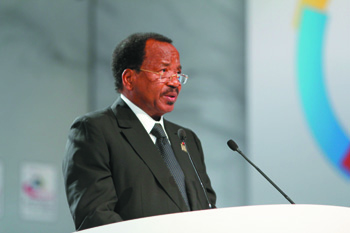 As a result of the world economic crisis between 2008 and 2009, real GDP growth slowed down, declining from 2.9% to 1.9%. Thus, the 4.5% growth rate expected for next year seems like a significant pick-up for the authorities.
As a result of the world economic crisis between 2008 and 2009, real GDP growth slowed down, declining from 2.9% to 1.9%. Thus, the 4.5% growth rate expected for next year seems like a significant pick-up for the authorities.
The growth rate of Cameroon's gross domestic product could reach 4.5% in 2012, i.e. one point more than in 2011. However the economic crisis of 2008 has had devastating effects on the sensitive areas of Cameroon's economic activity. Oil, wood, aluminium, cotton, rubber, banana and the railway sector have been severely affected.
An Unused land potential
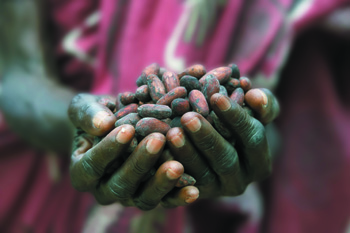 In this country called « Africa in miniature », nestled at the heart of the Equator with its head at the starting point of the Sahel, the agro-ecological zones are so diverse that there is land for all sorts of crops. According to evaluations of the Ministry of Agriculture and Rural Development, the overall arable land is estimated at about 7.2 million hectares, but only 1.8 million hectares are effectively cultivated. Likewise, while the irrigable potential is estimated at 240?000 hectares, less than 33?000 hectares are currently being irrigated. The Ministry further states that the development of Cameroon's agricultural potential "is still very poor because only 17% of the irrigable land is used, while only 26% of arable land is cultivated".
In this country called « Africa in miniature », nestled at the heart of the Equator with its head at the starting point of the Sahel, the agro-ecological zones are so diverse that there is land for all sorts of crops. According to evaluations of the Ministry of Agriculture and Rural Development, the overall arable land is estimated at about 7.2 million hectares, but only 1.8 million hectares are effectively cultivated. Likewise, while the irrigable potential is estimated at 240?000 hectares, less than 33?000 hectares are currently being irrigated. The Ministry further states that the development of Cameroon's agricultural potential "is still very poor because only 17% of the irrigable land is used, while only 26% of arable land is cultivated".
The hallmarks of modern agriculture
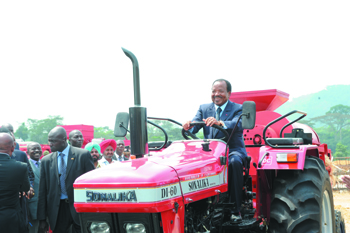 Dubbed "the Show of the modern era", the agro pastoral fair of Ebolowa, in the South, will have provided thousands of participants with the opportunity to discover one of the first milestones of this new agriculture.
Dubbed "the Show of the modern era", the agro pastoral fair of Ebolowa, in the South, will have provided thousands of participants with the opportunity to discover one of the first milestones of this new agriculture.
Thus, on 20 January 2011, President Paul Biya was able to try out Sonalika-made combine harvester with the words "Assembled in Cameroon". "This can revolutionize our agriculture. It is strategic. This is the future Cameroonian agriculture", the Head of State said congratulating the Minister of Economy, Louis Paul Motazé, architect of the project. He further requested the latter to immediately initiate reflections to facilitate the accessibility of these agricultural machines to as many farmers as possible.
In favor of local processing
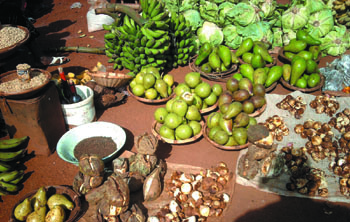 The production of perennial export crops like cocoa and coffee have risen substantially. Thus, cocoa production has reached 230000 tons.
The production of perennial export crops like cocoa and coffee have risen substantially. Thus, cocoa production has reached 230000 tons.
In this area, Sodécao, a State-owned corporation responsible for promoting this crop, presented the accomplishments made during the Ebolowa Show, and its action programme in terms of intensifying the selected nurseries, opening evacuation routes and organizing rural markets. In 2010, coffee, a traditional Cameroonian crop, registered a production of 50000 tons for robusta coffee and 12000 tons for Arabica coffee.
Central Africa: COBAC in the dock
Half a dozen cases pending before the Central African Court of Justice involve local banks and the community organ in charge of regulating the banking sector. The reorganization of the banking sector in Central Africa is far from being complete. Recently, the Court of Justice of the Economic and Monetary Community of Central Africa (Cemac) was particularly in demand for cases involving local banks and the regulatory body, COBAC.
Six of them involved banks of the sub-region and the regulatory body. The cases were referred to the hearing of 23 June 2011, where a final ruling was to be made on some of them.
Cameroon : The insurance sector on track
The uptrend observed these past years should be confirmed in the coming years. Between 2009 and 2010, the turnover was expected to register a 7% increase according to an analysis of the Association of Insurance Companies of Cameroon (ASAC).
Six months after the first Cameroonian Insurance Days whose primary objectives include popularizing this profession to the general public, the insurance sector is undergoing changes. Following the difficult situation arising from the international financial crisis, there are signs of revival which need to be confirmed and consolidated. In all likelihood, the restructuring conducted under the aegis of the Inter-African Commission on Insurance Markets (CIMA) in the 1990s helped to prepare the ground, and led to the current dynamism and the gradual restoration of confidence due to the increasingly manifest reliability of insurance companies.
Central Africa: COBAC in the dock
Half a dozen cases pending before the Central African Court of Justice involve local banks and the community organ in charge of regulating the banking sector.
The reorganization of the banking sector in Central Africa is far from being complete. Recently, the Court of Justice of the Economic and Monetary Community of Central Africa (Cemac) was particularly in demand for cases involving local banks and the regulatory body, COBAC. Six of them involved banks of the sub-region and the regulatory body. The cases were referred to the hearing of 23 June 2011, where a final ruling was to be made on some of them.
« I have a passion for the development of Cameroon and Africa! »
Considering the size of the villa in which we were received in his village in Bansoa on Saturday 16 April, it is impossible to believe that the person earning just 200 CFAF (less than 50 centimes of a euro) per day at the beginning of his career at age eighteen, has become one of the most outstanding industrialists in Cameroon's economic landscape today. Better still. With no higher education qualifications, Dieudonné Bougne is one of the forerunners of green business and the setting up of eco-businesses in Cameroon and in Central Africa, where the 'Groupe Bocom' is in full expansion: local processing of raw materials, industrial ecosystems, environmental preservation, support to local communities and the development of Africa are the primary obsessions of this exceptional entrepreneur.
IFC favorable to the strengthening of its support for Cameroon
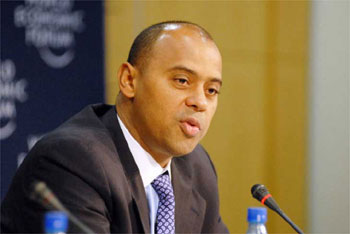 IFC whose scope of action was based in particular on supporting the financial sector is favorable for strengthening and diversifying its activities in Cameroon, to assist this country to the path of economic emergence
IFC whose scope of action was based in particular on supporting the financial sector is favorable for strengthening and diversifying its activities in Cameroon, to assist this country to the path of economic emergence
The ambition of the Cameroonian authorities to make Cameroon an emerging country by 2035 passes inevitably by the realization of structuring investment projects. This is a goal which can't be achieved at this stage without the support of development partners, bilateral or multilateral, among which the donors like the international monetary institutions of Bretton Woods. In this regard, the World Bank is part of the international financial institutions who agreed to accompany Cameroon on the path of its economic emergence.
From 5% to 10% of African investments
The International Finance Corporation (IFC), including a delegation led by Vice President for Sub-Saharan Africa, Latin America and the Caribbean and Western Europe, Thierry Tanoh, visited Cameroon during February, and reiterated the availability of this financial institution belonging to the World Bank group, whose responsibilities include operations with the private sector, to increase its participation in financing a number of development projects.
After discussions with the Cameroon government and the business community, namely the inter Employers Group of Cameroon (GICAM), the mission of the IFC has agreed to the need not only to strengthen its presence, which was simply a virtual support around the financial sector, but also to diversify it by putting a point on developmental projects which are vital for strong growth and sound economic development.
This is a goal which can only be achieved by relying on a dynamic and effective economic policy. Currently, Cameroon accounts for only 5% of the annual investment of IFC in Africa, meaning 150 million dollars (75 billion FCFA). These figures are well below the economic potential of Cameroon as it is said from both sides. Experts from the IFC consider that these investments should reach more than 10% of its current volume, accounting around 150 billion FCFA per year. The cumulative commitments of IFC, at 31st of December 2010 reached 237 billion FCFA only, while there are reliable indications that expect about 500 billion FCFA. Based on relevant aspects, IFC estimates that over the financial sector, which has always been its area of operation in Cameroon, it is necessary to strengthen and expand this partnership by providing considerable support in the growth sectors, like the oil, industry, energy and infrastructure. A diversification of fields of intervention that meets the new economic vision of the country ensures the Cameroonian government.
Central Africa has a guarantee fund for banks
The body responsible for guaranteeing and safeguarding the deposits of savers is now operational within the countries of the Economic and Monetary Community of Central Africa (CEMAC).
The Deposit Guarantee Fund in Central Africa (FOGADAC), created seven years ago by the Banking Commission of Central Africa (COBAC), it was born at the end of the first meeting of its committee last February in Yaoundé. This is a mechanism to protect deposits, or a deposits insurance system, financed by contributions from banks, varying according to the deposits they collect, with a minimum height of 30 million FCFA by bank and 5 million FCFA per financial institution which is not collecting deposits.
In return, the FOGADAC will reimburse savers' deposits and other assets placed with banks in the CEMAC (Economic and Monetary Community of Central Africa), up to 5 million FCFA maximum, in case of difficulties for these financial institutions.
Community structure responsible for guaranteeing savers' deposits of banks in Central Africa, FOGADAC was born fifteen years after the beginning of thinking about how to secure bank deposits in CEMAC zone following the banking crisis that shook the countries of the sub-region in the early 1990s, pushing more banks into bankruptcy, to the dismay of thousands of savers, many of which have never been able to recover all of their assets even to this day. COBAC, who was born in the aftermath, has begun a huge job of cleaning through bank restructuring which now provides to local banking institutions a minimum of credibility. This is why, in addition to ensuring the safety of savers' deposits, the FOGADAC should play a role in the financing of the sub-regional economy by banks, whose involvement in development projects is fairly low.
Bank deposits
Over the past decade, the number of active banks has increased from twenty-nine to forty-four, for total bank deposits of 4.995 billion FCFA against 1.637 billion FCFA. These figures represent an increase of 205%. At the same time, credits to the economy have also followed an upward trend, rising from 1397 billion FCFA in 2000 to 3034 billion FCFA in 2010, an increase of 117.1%. It should, however, put things into perspective when one considers that for the same period, the share of bank deposits and the credits to the economy relative to GDP remained low, rising from 2000 to 2009, respectively from 10, 9% to 16.7% and from 9.3% to 10.2%. Moreover, the average interest for loans fell from 14.3% in 2000 to 9.3% in 2009. This is a decline in a row consecutive to a tougher competition in the banking sector, which registered newcomers.
However, as experts note, there are concerns relating to the organization of FOGADAC. And for good reason, in addition to the permanent secretariat, which plays just a leadership role, it is chaired by the Governor of the Bank of Central African States (BEAC), which at the same time, is president of COBAC and the Monetary Policy Committee (MPC) of central Africa, while the other members of the governing body are representatives of the six states of CEMAC.
Based on the composition of legislative and operational bodies, analysts fear the risk of a "collusion of interests." Also, they observe that there remains a "blur from the place of subsidiaries of foreign banks outside CEMAC," since it is not clearly specified whether this is also an entitled guarantee mechanism of the sub-region. If this is not the case, there is a concern for the guarantee of national deposits of CEMAC having deposited their assets in the branches of multinational companies. Another concern, and not a little one, the cap to 5 million FCFA as a guarantee of repayment would be quite simplistic, declare the experts.
BGFI Bank moved to Cameroon
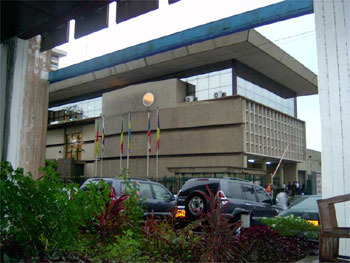 The Franco-Gabonese bank, presented as the leading financial group in Central Africa, has officially started its activities in Cameroon in March 2011. The country of Paul Biya should quickly become one of the development hubs, according to the development plan provided by this financial institution.
The Franco-Gabonese bank, presented as the leading financial group in Central Africa, has officially started its activities in Cameroon in March 2011. The country of Paul Biya should quickly become one of the development hubs, according to the development plan provided by this financial institution.
The International Gabonese and French Bank (BGFI Bank) officially started its activities in Cameroon on 7th March 2011, with the inauguration of its first branch in the economic metropolis of Douala. The opening of the agency comes six months after obtaining the approval from the Banking Commission of Central Africa (COBAC) and the quietus of the Cameroonian government. BGFI Bank arrives in an open banking environment, marked by the presence of subsidiaries of French, American and British multinational banks alongside the African and Cameroonian one, all accounting a dozen banking institutions operating in Cameroon.
In this competitive environment, BGFI Bank, which is the first investment group in the CEMAC zone, with total assets amounting 1078 billion FCFA in 2010, intends to offer a range of products in the fields of banking and finance. Inter alia, banking, asset management, stocks, cash, real estate, factoring, FINATRA, the Loxia, the EMF. The development plan presented by the Chief of BGFI Bank for Cameroon, Eric Masbou, forecasts for this year the opening of three more branches, one in Yaoundé and two in Douala, the national headquarters of the bank. "The implementation of BGFI Bank in Cameroon is part of the internationalization of the bank, whose objective is to ensure the sustainability of the group. Our mission is to offer customers a range of value-added services in perfect harmony with its immediate and future expectations.", as he said.
Bank restructuring
In its capacity as the locomotive of CEMAC, Cameroon is an important market for BGFI Bank therefore the Cameroonian subsidiary begins its operations with a capital of 10 billion FCFA. Currently, BGFI Bank operates in nine countries: Gabon, Congo, Equatorial Guinea, Democratic Republic of Congo, Benin, Madagascar, Côte d'Ivoire and France. Cameroon should quickly establish a development center from the perspective of deployment and strengthening of the activities of the banking group. Pending the completion of the administrative headquarters from Bananjo, the activities are confined at the agency called Prestige, located in the heart of the commercial district Akwa. It's an agency designed to primarily finance the activities of SME, but in the same time it remains open to other types of customers.
Among innovations and strategies to win market share, BGFI Bank counts on "the professionalism, the speed and the flexibility in the handling of cases." Therefore it is predicted for example, that, after establishing the complete file, responses to requests for credit are given in a period of seven days for individuals and fifteen days for businesses.
After the bank restructuring occurred fifteen years ago, the banking sector in Cameroon is getting more and more organized and structured, including an increased presence of banks in financing development projects, through an intervention model based on the syndication of banks.
Cameroon intends to double the country's oil production by 2015
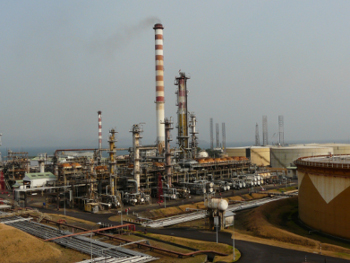 The research exploration across the country thus the modernization and expansion of the refinery has entered in a logical improvement of supply in order to meet a more and more important external demand
The research exploration across the country thus the modernization and expansion of the refinery has entered in a logical improvement of supply in order to meet a more and more important external demand
Despite a difficult international financial situation, the CEO of Sonara, Charles Metouck, was able to mobilize the necessary funding.
Currently ranked among the average oil producers in Africa, Cameroon continues to feed its ambition to increase the oil production of the country and play in the big leagues. Recently, a number of exploration and exploitation have been granted to international companies, the aim being to find and highlight locations with oil fields. Under the auspices of the National Hydrocarbons Corporation (SNH), the secular arm of the state in this field, onshore and offshore researches are underway in both Rio del Rey Basin in the Atlantic Basin, and in the loop Douala, Edéa, Limbé and Kribi.
Expansion and modernization of oil installations
While researches continues, the authorities have decided to proceed with the expansion and modernization of the country's only refinery, for an investment of 350 billion CFA francs allocated for the improvement of the production tool of the National Society of refining (SONAR). The first phase of work, which has begun in recent months, is coming to an end, opening the gap to the second phase, to be completed in less than three years. According to forecasts, oil production in Cameroon, which is currently at 2, 1 million tons per year, could reach 4 million tons per year, a doubling of national production which is expected by 2015.
Drawing conclusions from the past, the plant in expansion and full modernization respond effectively to the types of crude oils produced in Cameroon, which ensures that the amount of Cameroonian oil refined in Nigeria and other countries will now be made on site, which will be a gain in State’s revenue. Despite a difficult international financial situation, the CEO of Sonara, Charles Metouck, could raise the necessary funding through a loan from a syndicate of local banks and subsidiaries of multinationals, amounting 150 billion CFA francs for the achieving of the first phase of expansion which should be completed before the end of the current year.
Demand exceeds supply
After the start of earthworks and civil engineering, the next critical phase will consist of the equipment itself. Thus, among others will be provided a room equipped with a digital line before connecting to the various units and the construction of ten storage tanks for crude oil and finished products.
New capacities which will further increase the flexibility of the refinery in inventory management. Furthermore, the installation of a vacuum distillation will give the refinery more flexibility in its operations, with the possibility of treating large quantities of waste generated by atmospheric distillation according to the nature of selected crude oils. This is a feature that was not anticipated in the construction of the refinery, thirty years ago.
According to forecasts, oil production in Cameroon, which is currently 2, 1 million tons per year, could reach 4 million tons per year, a doubling of national production which is expected by 2015.
The domestic market is sufficiently covered; Sonara intends to strengthen its presence on continental and international market, particularly in the countries of the sub-region and those in the Gulf of Guinea, including Nigeria and Central African Republic, this area which already accounts 40% of current production of Sonara and where demand is still high. With countries that produce up to 17 million tons of oil annually in the Gulf of Guinea, including Angola and Nigeria, which are among the leading producers on the continent, Cameroon, which acts now as the average producer, wants at least to occupy the fifth rank in Africa within the next decade. In addition, it intends to make a prominent place in Europe and the United States, with products of Sonara whose quality is recognized in this sector yet known as sharp and competitive.
Page 5 of 5


